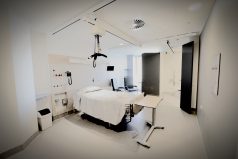Safe Patient Handling Coordinator
A small community hospital of 150 operating beds has recently experienced an increase in patient-lift incidents resulting in employee injuries over the past year and a half to include one high-profile incident which resulted in a patient injury. As part of the ongoing efforts to find a solution to this problem, in-depth analysis revealed that out of 150 operating beds, over 70% are consistently occupied by patients with very limited mobility requiring staff to have to concentrate more on performing the physical tasks associated with patient care. Meanwhile, as patient handling injuries continue to climb, nursing units have become more difficult to staff while nurse’s morale continues to decline.
Safe Patient Handling Program and Integration
The Safety Manager of a 350-hospital bed Medical Center has become concerned since an increase of 20 employee patient handling injuries at the turn of the 4th Quarter of the current Fiscal Year. It is noted that injury increases did not begin until the Safe Patient Handling consultant service that was purchased along with the facility’s $1.5 million comprehensive patient-lift equipment expansion project ended their contract just under 2 years ago. The Safety Manager is unsure why staff has suddenly stopped using available patient-lift equipment. The manager has considered purchasing more equipment as a solution while contemplating the development of a Safe Patient Handling coordinator position. The Medical Center is planning to relocate in 3 years and hospital administration is in support of continuing its “No-Lift” program. The Safety Manager is desperate for a long-term solution as the facility begins planning for the move into their new building location.
Procurement Optimization
In a 900 bed Medical Center, two nurse managers from different units discovered a need to address employee injuries related to patient handling on their units. Both nurse managers researched a variety of options while both concluded that purchasing mechanical ceiling-lifts to lift their patients provided the best option. The manager from the first nursing unit decided to contact Vendor A to set-up a demonstration / in-service for her staff. The manager from the second unit also contacted a ceiling-lift company for the same purposes which happened to be a different vendor, Vendor B. While both managers and their employees were pleased with the products and demonstrations, the procurement process was initiated leaving both managers feeling a sense of relief that their employee injury issue had been resolved.
Injury Trend Consulting
The Employee Health Director of a large 600 bed Medical Center recently observed a 30% increase in nursing injuries from FY15 to FY16. He identified data which revealed increases in injuries in the facility’s Intensive Care Unit, Emergency Room and the Spinal Rehabilitation Units. Staff who reported these injuries acknowledged that they had participated in the hospital’s patient-lift classes as part of the facility’s annual competency assessment while openly praising the information provided by the instructor who happened to be one of the hospital’s Physical Therapists. The Employee Health Director remained unsettled as for why patient handling injuries were consistently increasing and decided to take action.






